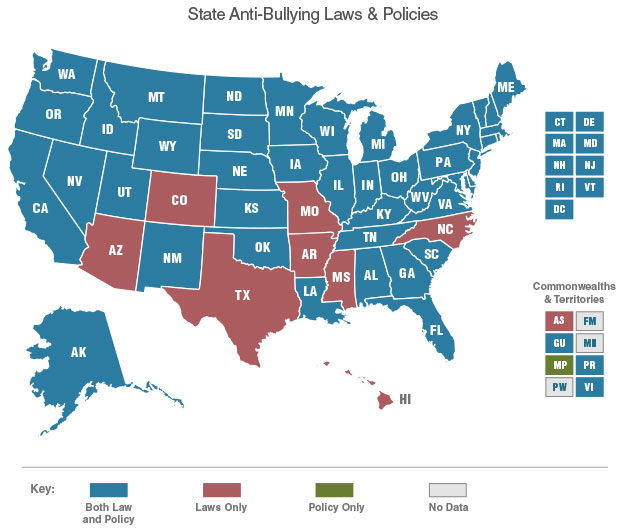In This Section
Know Your Rights
Rights as defined in Wikipedia, are legal, social, or ethical principles of freedom or entitlement; that is, rights are the fundamental normative rules about what is allowed of people or owed to people, according to some legal system, social convention, or ethical theory. Source: Wikipedia (Note: Wikipedia provides additional context about the definition of rights and the controversy surrounding the meaning.)
Students in every state have rights in a bullying situation. However, every state addresses bullying differently. Some states have specific laws, while others have policy or legislation that outlines student rights in a bullying situation.
It is important for you to know
Some laws and policies specifically outline that the students who:
- Are bullied should be provided support and strategies designed to keep them safe and prevent further bullying
- Do the bullying should be given consequences which are appropriate for the situation and circumstances
- Witness bullying should have training on what to do when they see bullying and the role they can play in creating a safe school community
It is your right to be safe at school
Every student should feel safe at school; if you do not, seek help from your parents or another adult, such as your teacher, an administrator, or a person you trust at school. Remember to:
- Tell them about the bullying situation
- Let them know that if you could have stopped this on your own, you wouldn’t be asking for their help
- Remind them that there are laws or policies outlining the school’s responsibility in handling bullying situations
- Get their help to review the school’s policy and determine how it applies to your situation
- Close with, “What can be done so that all students at the school and I feel safe?”
State Laws that Address Bullying
To learn more about your state’s law check out the interactive map on the StopBullying.gov website.
State laws might include the following:
- Purpose statement – outlines the detrimental effects of bullying and declares that bullying of any kind is unacceptable.
- Statement of scope – explains what settings this policy covers.
- Specification of prohibited conduct – includes a specific definition of bullying, including cyberbullying and is consistent with other federal, state, and local laws.
- Enumeration of specific characteristics – lists actual or perceived characteristics that have historically been targets of bullying.
- Development and Implementation of LEA (local educational agencies)- requires ever school to develop and implement a bullying prevention policies.
- Review of local policies – requires states to review local policies on a regular basis.
- Communication plan – includes a plan for notifying students, parents, and staff about bullying prevention policies.
- Training and preventive education – school districts must provide training for all school staff.
- Transparency and monitoring – requires schools to report annually to the state the number of bullying incidences.
Learn more at StopBullying.gov.
Federal Laws That Address Harassment
Students may have additional protections under federal law when the bullying is based on:
- Race, color, or national origin
- Sex
- Religion
- Disability
When the bullying is about someone’s race, color, national origin, sex, religion, or disability – at the federal level – this is called harassment.
Some state and local laws may provide additional protections on other bases, including bullying that happens because of real or perceived sexual orientation.
School Policies
School districts generally have bullying prevention policies. The policies varies from school to school and from state to state. These are often printed in the school handbook or posted on the school website. The policies can include, but are not limited to the following:
- Definition of behavior
- Reporting procedure
- Informing parents
- Consequences for person bullying
- Support for the target of the bullying
Influencing Decision makers
As a student, you have a strong voice in influencing peers, educators, and administrators within your school. You also can persuade lawmakers to explore changes in laws to protect students. Bullying is an issue that directly affects students and school culture. When you lead the cause, you show you care about other students and your school—and you become a powerful voice for change.
